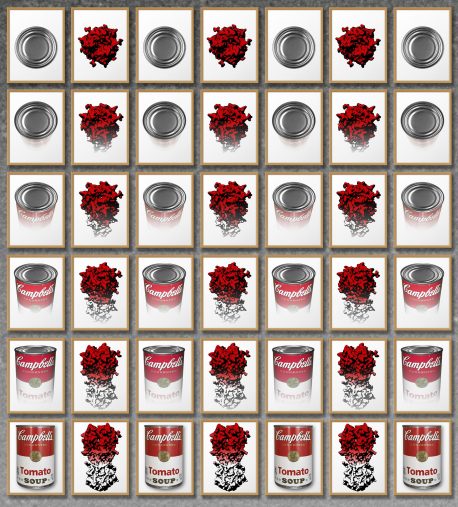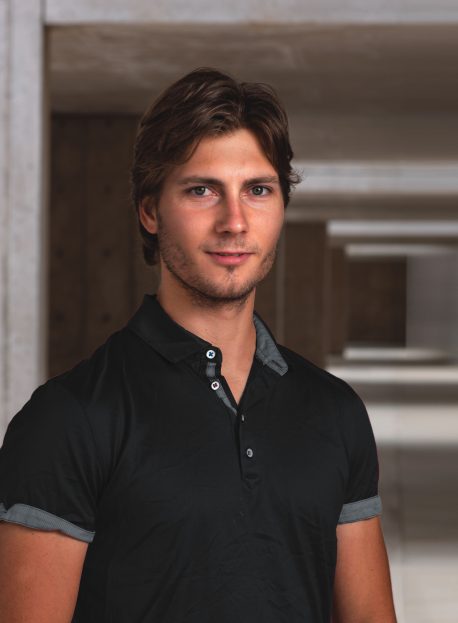
July 3, 2017
Salk Institute researcher describes new cryo-EM method to facilitate a better understanding of proteins involved in disease
Salk Institute researcher describes new cryo-EM method to facilitate a better understanding of proteins involved in disease
LA JOLLA—The conventional way of placing protein samples under an electron microscope during cryo-EM experiments may fall flat when it comes to getting the best picture of a protein’s structure. In some cases, tilting a sheet of frozen proteins—by anywhere from 10 to 50 degrees—as it lies under the microscope, gives higher quality data and could lead to a better understanding of a variety of diseases, according to new research led by Salk scientist Dmitry Lyumkis.

Click here for a high-resolution image.
Credit: Salk Institute
“People have tried to implement tilting before, but there have been a lot of challenges,” says Lyumkis, a Helmsley-Salk Fellow at the Salk Institute and senior author of the new work, published July 3, 2017, in Nature Methods. “We’ve eliminated many of these problems with our new approach.”
Cryo-EM, or cryo-electron microscopy, is a form of transmission electron microscopy in which samples are quickly cooled to below freezing before being imaged under the microscope. Unlike other methods commonly used to determine the structure of proteins, cryo-EM lets proteins remain in their natural conformations for imaging, which could reveal new information about the structures. Understanding proteins’ structures is a vital step to developing new therapies for disease, such as in the case of HIV.
Researchers have long assumed that proteins adopt random conformations throughout the frozen grid that’s prepared for cryo-EM experiments, which means that by taking enough images, researchers can put together a full, 3D picture of the protein’s shape(s) from all imaging directions. But for many proteins, the approach seems to fall short, and parts of the proteins’ structures remain missing.
“Researchers are starting to think that the proteins on a cryo-EM grid don’t adopt random conformations after all, but rather stick to the top or bottom of the sample grid in preferred orientations,” says Lyumkis. “Thus we may not be getting the full picture of proteins’ structures. More importantly, this behavior can prohibit structure determination altogether for select protein samples.”
To understand the problem, imagine trying to look at the shadows of a dozen tin cans to figure out their shape but seeing only circles because all the cans are exactly upright. By making the light—or electron beam, in the case of cryo-EM—hit the samples at an angle, though, you’d be able to see the true shape better.
When researchers have tried to tilt samples under a microscope in the past, they’ve been limited by poor resolution: an angle means that the electron beam has to travel through a thicker grid. Samples are also more likely to move within the frozen grid when they’re tilted, blurring out the data. And technically, analyzing data from a tilted sample is also more challenging, since cryo-EM methods were designed with the assumption that the grid containing proteins was always at the same distance from the microscope.

Click here for a high-resolution image.
Credit: Salk Institute
To tackle these challenges, Lyumkis and his colleagues changed the materials used to create the cryo-EM grid, recorded movies of their data rather than still images, and developed new computational methods to analyze the information.
When they tested the new approach on the influenza hemagglutinin protein, a notoriously hard protein to characterize using cryo-EM, the team found that tilting the sample gave a more complete dataset. When the protein sample was flat, typical algorithms introduced false positive shape to the protein that wasn’t backed up by experimental data. That wasn’t the case when it was tilted.
“Due to the geometry of the data collection when we tilt, we fill up much more data characterizing the molecules, giving us a more complete picture of the protein’s shape” says Lyumkis.
The algorithms that Lyumkis and his team developed—which include ways to analyze whether a cryo-EM experiment is introducing bad data, as well as the methods to interpret a tilted experiment—are now openly available. They hope other researchers will start using them and that it becomes a standard metric for cryo-EM structure validation (since most experimentally derived structures suffer from missing information to different extents).
“One of the ideas we’re looking at now is whether data collection should always be performed at a tilt rather than in the conventional way,” says Lyumkis. “It won’t hurt and it should help.”
Other researchers on the study were Yong Zi Tan, Philip Baldwin, Clinton Potter and Bridget Carragher of the New York Structural Biology Center, and Joseph David and James Williamson of The Scripps Research Institute.
The work and the researchers involved were supported by grants from the Agency for Science, Technology, and Research Singapore, the Leona M. and Harry B. Helmsley Charitable Trust, the U.S. National Institutes of Health, the Jane Coffin Childs Foundation, the National Institute of Aging, the National Institute of General Medical Sciences and the Simons Foundation.
JOURNAL
Nature Methods
AUTHORS
Yong Zi Tan, Philip R Baldwin, Joseph H Davis, James R Williamson, Clinton S Potter, Bridget Carragher and Dmitry Lyumkis
Office of Communications
Tel: (858) 453-4100
press@salk.edu
Unlocking the secrets of life itself is the driving force behind the Salk Institute. Our team of world-class, award-winning scientists pushes the boundaries of knowledge in areas such as neuroscience, cancer research, aging, immunobiology, plant biology, computational biology and more. Founded by Jonas Salk, developer of the first safe and effective polio vaccine, the Institute is an independent, nonprofit research organization and architectural landmark: small by choice, intimate by nature, and fearless in the face of any challenge.